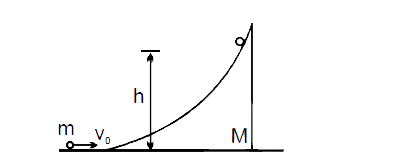A mass m, moving horizontally with a velocity v0 strikes as pendulum of mass m. If the masses stick together after the collision , then the maximum height reached by the pendulum is
vf20/g
v202g
v20/4g
v208g
The correct Answer is:D
By conservation of linear momentum , (2m) v=mv0+0orv=v02 (i)
∵ Potential energy = kinetic energy ∴(2m)gh=12(2m)v2⇒h=v22g (ii)
or h=v22g=(v02)2×12g=v208g∴ height reached by the pendulum =v208g
Similar Questions
A mass of 10 g moving horizontally with a velocity of 100cm−1 strikes a pendulum bob of mass 10g. Length of string is 50 cm. The two masses stick together. The maximum height reached by the stystm now is (Take, g=10ms−2

View SolutionA mass of 10 gm moving with a velocity of 100 cm / s strikes a pendulum bob of mass 10 gm . The two masses stick together. The maximum height reached by the system now is (g=10m/s2)
View Solution
Knowledge Check
A mass of 10 gm moving with a velocity of 100 cm / s strikes a pendulum bob of mass 10 gm . The two masses stick together. The maximum height reached by the system now is (g=10m/s2)
AzeroB5 cmC2.5 cmD1.25 cmA particle of mass m moving with velocity V0 strikes a simple pendulum of mass m and sticks to it. The maximum height attained by the pendulum will be
AV208gB√V0gC2√V0gDV204gA particle of mass m moving with velocity V0stick a simple pendulum of mass m and stick to it. The maximum height attained by the pendulum will be
Ah=V208gB√V0gC2√V0gDV204g
A ball of mass 'm' moving with a horizontal velocity 'v' strikes the bob of mass 'm' of a pendulum at rest. During this collision, the ball sticks with the bob of the pendulum. The height to which the combined mass raises is (g = acceleration due to gravity).
View SolutionA particle of mass m moving horizontal with v0 strikes a smooth wedge of mass M, as shown in figure. After collision, the ball starts moving up the inclined face of the wedge and rises to a height h.

The maximum height h attained by the particle is
View SolutionA particle of mass m moving horizontal with v0 strikes a smooth wedge of mass M, as shown in figure. After collision, the ball starts moving up the inclined face of the wedge and rises to a height h.

The final velocity of the wedgev2 is
View SolutionA particle of mass m moving horizontal with v0 strikes a smooth wedge of mass M, as shown in figure. After collision, the ball starts moving up the inclined face of the wedge and rises to a height h.

When the particle has risen to a height h on the wedge, then choose the correct alternative(s)
View SolutionA ball of mass 'm' moving with a horizontal velocity 'v' strikes the bob of mass 'm' of a pendulum at rest. During this collision, the ball sticks with the bob of the pendulum. The height to which the combined mass raises is (g = acceleration due to gravity).
View Solution
